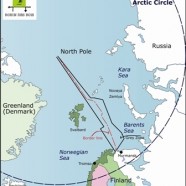There is movement in the Arctic
On July 7th 2011 a maritime border agreement between Russia and Norway entered into force. This new dividing line ends a 44 year dispute over 175,000 square kilometres in the Barents and Arctic seas and opens up the former so called “grey zone” for exploration. The day following the entry into force Norway deployed the Harrier Explorer (Imo 7807380) a seismic vessel to start exploration in the zone.
This border agreement follows a Treaty on Cooperation on Aeronautical and Maritime Search and Rescue in the Arctic on May 12th 2011. It is the first legally binding treaty under the circumpolar intergovernmental forum the Arctic Council and was signed in Nuuk Greenland by Canada, Denmark, Finland, Iceland, Norway, Russia, Sweden and the United States of America. The Treaty so called the “Nuuk Agreement” is focused on saving lives. It is an important step towards policy-making as there is an increasing amount of traffic venturing into the Arctic, which includes tankers and passenger ships of which a number were not constructed to navigate in ice-covered waters.
There is movement in the Arctic
On July 7th 2011 a maritime border agreement between Russia and Norway entered into force. This new dividing line ends a 44 year dispute over 175,000 square kilometres in the Barents and Arctic seas and opens up the former so called “grey zone” for exploration. The day following the entry into force Norway deployed the Harrier Explorer (Imo 7807380) a seismic vessel to start exploration in the zone.
This border agreement follows a Treaty on Cooperation on Aeronautical and Maritime Search and Rescue in the Arctic on May 12th 2011. It is the first legally binding treaty under the circumpolar intergovernmental forum the Arctic Council and was signed in Nuuk Greenland by Canada, Denmark, Finland, Iceland, Norway, Russia, Sweden and the United States of America. The Treaty so called the “Nuuk Agreement” is focused on saving lives. It is an important step towards policy-making as there is an increasing amount of traffic venturing into the Arctic, which includes tankers and passenger ships of which a number were not constructed to navigate in ice-covered waters.









